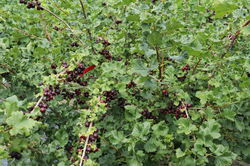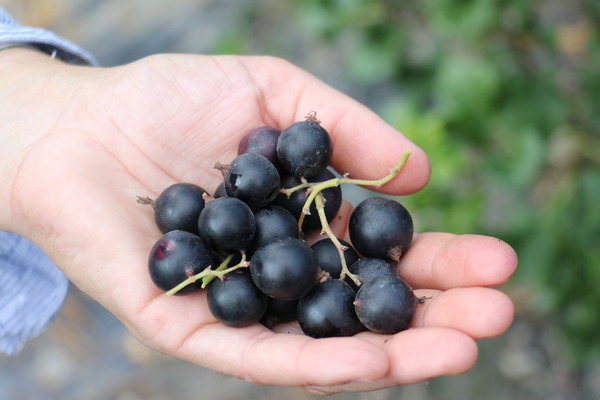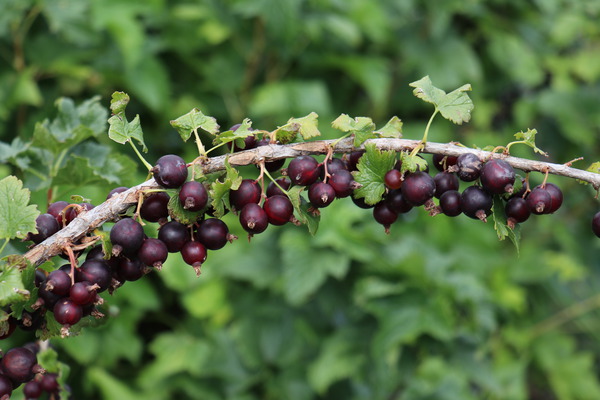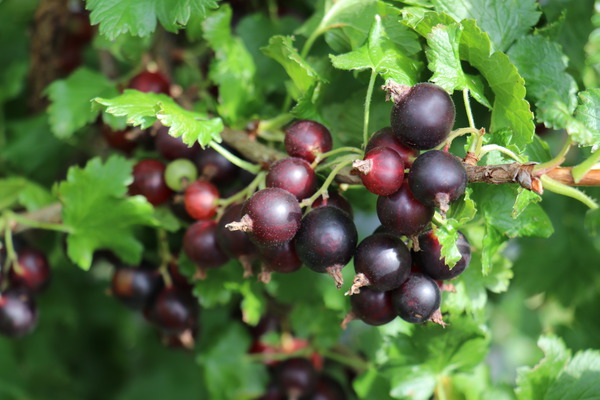 The horticultural or breeding vision of combining blackcurrants with gooseberries has existed since the end of the 19th century. The aim of these first crossing attempts was to combine the fruitiness and fruit size of gooseberries with the aroma of blackcurrants. In addition, this new fruit variety was also to have tolerance to American gooseberry powdery mildew. However, these first attempts were not successful...
The horticultural or breeding vision of combining blackcurrants with gooseberries has existed since the end of the 19th century. The aim of these first crossing attempts was to combine the fruitiness and fruit size of gooseberries with the aroma of blackcurrants. In addition, this new fruit variety was also to have tolerance to American gooseberry powdery mildew. However, these first attempts were not successful...
The Lubera® breeders were by no means the first to work on jostaberries. In the interwar years of the 20th century, German breeding institutes resumed the 'Ribes fusion' project, after the war the “jochelberry” varieties were created in the East of Germany and the jostaberries in the West (by Dr. Bauer). But at present, Lubera's josta breeding programme is the most current – and perhaps the only one working on josta. Lubera has mainly succeeded in improving fruit characteristics, but the greatest progress has been made in fertility. If the old jostaberry suffered from the fact that they bore only a few berries for the huge bush, now the fruitfulness is comparable to blackcurrants – and even the growth has become much more compact and gardenable.
Lubera Edibles® can now offer the new three jostaberry varieties as young plants.
Confi® berries – a new generation of jostaberries
If you were wondering when reading through the title whether it really makes sense to breed such a niche product, you probably have not yet had to produce jostaberries in a container, let alone tried to harvest a larger quantity of berries. Neither is necessarily easy with the genetic material that has been offered on the market so far.
But what is the problem with this fruit variety? The actual crossing (Ribes nigrum x Ribes uva-crispa) is easy to do and germinable seeds develop. Only now does the real problem begin. It is true that blackcurrants and gooseberries have the same ancestors in the distant past, but natural selection (evolution) and domestication by humans have made the two species very far apart. As much so that the offspring from a fusion cross grow, but basically do not set fruit and at the same time display tremendous vigour. This problem was solved and mastered only in the middle of the 20th century by very intensive and lengthy breeding work with the help of the natural alkaloid 'colchicine': the chromosome set of the gooseberry-cassis crosses was doubled so that the genes and chromosomes could get along better with each other, so to speak, and so that meiosis, the reduction division, would work (to some extent).
But the resulting varieties were still very vigorous and sometimes had more, sometimes less fruit set. This is also the reason why the jostaberries could never really establish themselves, although they are excellent for processing into juice, jelly or jam. And this is where the breeding work of Lubera® comes in...
The hypothesis of the Lubera® breeders was that by crossing two different josta cultivars, compatibility with themselves could be improved and thus fertility significantly increased. This was ultimately put into practice. And from the josta populations thus obtained, the most fertile and best varieties have been selected over the past 10 years: the Confi® berries.
The current Confi® berries range at Lubera Edibles
In the new Confi® berries, the main characteristics of the previous josta generation have now been significantly improved. The growth has been reduced and the bushes between 120 and 150 cm in height bear fruit abundantly.
However, the main focus of the fruit is still on processing, which is also made clear by the 'Confi® berry' brand.
Confi® Berry Jodeli® – the sweetest fruit with compact growth

Picture: fruits of the new Jostaberry Confi®Beere Jodeli®
This variety is much more compact in growth compared to the older josta varieties, with a height of 150 cm after 5 years. The very large berries can grow up to 20 mm and are much sweeter in taste than the other varieties and therefore also the best choice for eating fresh.
Short description of Confi®Berry Jodeli®:
- Growth: compact, round growth with good branching of the older branches; after five years about 150 cm high
- Maturity/harvest: early to mid-July; wait until the fruits have turned from red to black and thus enough sugar has been formed; the uniform ripening allows a concentrated harvest
- Berries/strings: up to 20 mm large berries on compact strings with 3-5 berries
- Flavour: pleasantly sweet with a fruity aroma when fully ripe, very mild compared to other varieties
Confi®Berry Jofruity® – the earliest jostaberry with the highest fruitfulness

BPicture: fruits of the new Jostaberry Confi®Beere Jofruity®
This variety has the highest fruitfulness of all Confi® berry varieties and therefore also the most compact growth. With a ripening period starting in early July, Jofruity® is also the earliest variety of Confi® berries. In terms of taste, Jofruity® is more influenced by the gooseberry than the blackcurrant.
Short description of Confi® Berry Jofruity®:
- Growth: the weakest growing variety, after five years only 120 – 140 cm high, with characteristic arching shoots; Jofruity® should be rejuvenated somewhat faster than the other Confi® berries
- Maturity/harvest: early July, earlier than Jodeli®; fruits do not turn completely black, but should be harvested as dark as possible
- Berries/strings: rather smaller berries with 12 - 14 mm in diameter; the fruitfulness (yield per unit of crown volume) is, however, greater than with Jodeli® or Jogusto®
- Flavour: refreshing, fruity taste; more influenced by the gooseberry than the blackcurrant
Confi® Berry Jogusto® – the latest Confi® berry with the strongest growth

Picture: fruits of the new Jostaberry Confi®Beere Jogsto®
Jogusto® is the latest Confi® berry, ripening from the beginning of August. In terms of growth character, this variety, with a growth height of up to 180 cm, is still quite close to the older josta varieties. Nevertheless, Jogusto® also has a significantly higher fruit yield.
Short description of Confi® Berries Jogusto®
- Growth: strong growing, up to 180 cm high
- Maturity/harvest: late ripening, from the beginning of August; when fully ripe, the fruits are almost black and only then taste really good; the red, still unripe fruits are very sour; for processing, however, the whole bush can be harvested as soon as 2/3 of the fruits turn black
- Berries/strings: large to very large berries, up to 18 mm in diameter
- Flavour: fresh and sourish; a late harvesting time is very important here
Josta breeding at Lubera®
Due to the very low fruit characteristics of the originally crossed blackcurrants and gooseberries, further inbreeding of the jostaberries will hardly bring further significant success in fruit size. Therefore, this approach is no longer pursued by Lubera® breeders.
However, there has been considerable progress in the past decades since the origins of josta breeding in the varietal characteristics of gooseberries (significantly larger fruits, better taste, improved plant/leaf health) on the one hand, but also in blackcurrants (fruit size, bunch size, taste, tolerance/resistance to powdery mildew) on the other hand. The potential results of crossing a blackcurrant with over 20 mm fruit size and, for example, the gooseberry Crispa® Goldling® are hard to foresee. Nevertheless, even with the introduction of the Confi® berries, jostaberries remain a niche product – although they are now much more interesting for the hobby gardener. Our breeder colleagues at Lubera are often attracted precisely by the unrecognised, almost unknown fruit species. This is where the greatest and fastest progress can be made. Let's see if at some point they manage a new fusion of fruit from different Ribes species.
